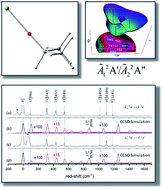A combined experimental and computational study on the
 transition of the calcium isopropoxide radical as a candidate for direct laser cooling†
transition of the calcium isopropoxide radical as a candidate for direct laser cooling†
Abstract
Vibronically resolved laser-induced fluorescence/dispersed fluorescence (LIF/DF) and cavity ring-down (CRD) spectra of the  electronic transition of the calcium isopropoxide [CaOCH(CH3)2] radical have been obtained under jet-cooled conditions. An essentially constant
electronic transition of the calcium isopropoxide [CaOCH(CH3)2] radical have been obtained under jet-cooled conditions. An essentially constant  energy separation of 68 cm−1 has been observed for the vibrational ground levels and all fundamental vibrational levels accessed in the LIF measurement. To simulate the experimental spectra and assign the recorded vibronic bands, Franck–Condon (FC) factors and vibrational branching ratios (VBRs) are predicted from vibrational modes and their frequencies calculated using the complete-active-space self-consistent field (CASSCF) and equation-of-motion coupled-cluster singles and doubles (EOM-CCSD) methods. Combined with the calculated
energy separation of 68 cm−1 has been observed for the vibrational ground levels and all fundamental vibrational levels accessed in the LIF measurement. To simulate the experimental spectra and assign the recorded vibronic bands, Franck–Condon (FC) factors and vibrational branching ratios (VBRs) are predicted from vibrational modes and their frequencies calculated using the complete-active-space self-consistent field (CASSCF) and equation-of-motion coupled-cluster singles and doubles (EOM-CCSD) methods. Combined with the calculated  electronic transition energy, the computational results, especially those from the EOM-CCSD calculations, reproduced the experimental spectra with considerable accuracy. The experimental and computational results suggest that the FC matrix for the studied electronic transition is largely diagonal, but transitions from the vibrationless levels of the à state to the
electronic transition energy, the computational results, especially those from the EOM-CCSD calculations, reproduced the experimental spectra with considerable accuracy. The experimental and computational results suggest that the FC matrix for the studied electronic transition is largely diagonal, but transitions from the vibrationless levels of the à state to the ![[X with combining tilde]](https://www.rsc.org/images/entities/char_0058_0303.gif) -state levels of the CCC bending (ν14 and ν15), CaO stretch (ν13), and CaOC asymmetric stretch (ν9 and ν11) modes also have considerable intensities. Transitions to low-frequency in-plane [ν17(a′)] and out-of-plane [ν30(a′′)] CaOC bending modes were observed in the experimental LIF/DF spectra, the latter being FC-forbidden but induced by the pseudo-Jahn–Teller (pJT) effect. Both bending modes are coupled to the CaOC asymmetric stretch mode via the Duschinsky rotation, as demonstrated in the
-state levels of the CCC bending (ν14 and ν15), CaO stretch (ν13), and CaOC asymmetric stretch (ν9 and ν11) modes also have considerable intensities. Transitions to low-frequency in-plane [ν17(a′)] and out-of-plane [ν30(a′′)] CaOC bending modes were observed in the experimental LIF/DF spectra, the latter being FC-forbidden but induced by the pseudo-Jahn–Teller (pJT) effect. Both bending modes are coupled to the CaOC asymmetric stretch mode via the Duschinsky rotation, as demonstrated in the  DF spectra obtained by pumping non-origin vibronic transitions. The pJT interaction also induces transitions to the ground-state vibrational level of the ν10(a′) mode, which has the CaOC bending character. Our combined experimental and computational results provide critical information for future direct laser cooling of the target molecule and other alkaline earth monoalkoxide radicals.
DF spectra obtained by pumping non-origin vibronic transitions. The pJT interaction also induces transitions to the ground-state vibrational level of the ν10(a′) mode, which has the CaOC bending character. Our combined experimental and computational results provide critical information for future direct laser cooling of the target molecule and other alkaline earth monoalkoxide radicals.




 Please wait while we load your content...
Please wait while we load your content...
 transition of the calcium isopropoxide radical as a candidate for direct laser cooling
transition of the calcium isopropoxide radical as a candidate for direct laser cooling